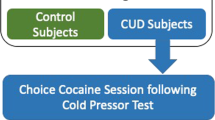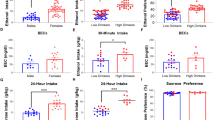Abstract
Striatal kappa opioid receptor (KOR) availability in 48 subjects with Alcohol Use Disorder (AUD) was previously found to be associated with degree of drinking following a week of naltrexone treatment (de Laat et al. Biological Psychiatry, 86(11), 864-871, 2019). The purpose of the current study was to determine if spectral clustering applied to previously acquired KOR images (with [11C]LY2795050 PET) could identify meaningful groupings of different responses to naltrexone and to assess the robustness of the finding. Spectral clustering was applied to 6 features (regional volume of distribution values, VT) per AUD subject to produce 3 classes of subjects with different mean responses to naltrexone. Response to naltrexone was quantified as the difference in drinks consumed in an established lab-based alcohol drinking paradigm (Krishnan-Sarin et al. Biological Psychiatry, 62(6), 694-697, 2007) prior to, and after a week of naltrexone treatment. Clustering was applied exclusively to features of the image data with no a priori knowledge of the subjects’ responses. Separation of classes was tested using a 1-way analysis of variance (ANOVA) with drink reduction as the outcome of interest. To assess robustness of the result, the size of the training set was varied by using successively reduced subsets of the data. Clustering resulted in significantly different groupings of drink reduction. The finding was robust to initialization of the spectral clustering procedure and was replicable for different random subsets of training subjects. Finding: Spectral clustering of kappa PET images separates AUD subjects into behaviorally distinct groups expressing distinct responses to naltrexone.

Similar content being viewed by others
Data availability
The data used in this study are not openly available at this time. Software and code are available upon request.
References
Anderson, R. I., & Becker, H. C. (2017). Role of the dynorphin/kappa opioid receptor system in the motivational effects of ethanol. Alcoholism: Clinical and Experimental Research, 41(8), 1402–1418.
de Laat, B., Goldberg, A., Shi, J., Tetrault, J. M., Nabulsi, N., Zheng, M.-Q., Najafzadeh, S., Gao, H., Kapinos, M., Ropchan, J., O'Malley, S. S., Huang, Y., Morris, E. D., & Krishnan-Sarin, S. (2019). The kappa opioid receptor is associated with naltrexone-induced reduction of drinking and craving. Biological Psychiatry, 86(11), 864–871.
Ichise, M., Toyama, H., Innis, R. B., & Carson, R. E. (2002). Strategies to improve Neuroreceptor parameter estimation by linear regression analysis. Journal of Cerebral Blood Flow & Metabolism, 22(10), 1271–1281.
Kim, S. J., Zheng, M. Q., Nabulsi, N., Labaree, D., Ropchan, J., Najafzadeh, S., Carson, R. E., Huang, Y., & Morris, E. D. (2013). Determination of the in vivo selectivity of a new kappa-opioid receptor antagonist PET tracer 11C-LY2795050 in the rhesus monkey. Journal of Nuclear Medicine, 54(9), 1668–1674.
Krishnan-Sarin, S., Krystal, J. H., Shi, J., Pittman, B., & O’Malley, S. S. (2007). Family history of alcoholism influences naltrexone-induced reduction in alcohol drinking. Biological Psychiatry, 62(6), 694–697.
O'Malley, S. S., Krishnan-Sarin, S., Farren, C., Sinha, R., & Kreek, M. (2002). Naltrexone decreases craving and alcohol self-administration in alcohol-dependent subjects and activates the hypothalamo–pituitary–adrenocortical axis. Psychopharmacology, 160(1), 19–29.
Shen, X., Papademetris, X., & Constable, R. T. (2010). Graph-theory based parcellation of functional subunits in the brain from resting-state fMRI data. Neuroimage, 50(3), 1027–1035.
Substance Abuse and Mental Health Services Administration. (2020). Key substance use and mental health indicators in the United States: Results from the 2019 National Survey on Drug Use and Health (HHS Publication No. PEP20-07-01-001, NSDUH Series H-55). Rockville, MD: Center for Behavioral Health Statistics and Quality, Substance Abuse and Mental Health Services Administration. Retrieved from https://www.samhsa.gov/data/. 2022.
Vijay, A., Cavallo, D., Goldberg, A., de Laat, B., Nabulsi, N., Huang, Y., Krishnan-Sarin, S., & Morris, E. D. (2018). PET imaging reveals lower kappa opioid receptor availability in alcoholics but no effect of age. Neuropsychopharmacology, 43(13), 2539.
Funding
The study was supported by the National Institute on Alcohol Abuse and Alcoholism (Grant No. AA021818 to EDM and SK-S), the National Center for Advancing Translational Sciences (Grant No. UL1 TR000142 to Yale School of Medicine–Hospital Research Unit), and the Yale Center for Translational Neuroscience of Alcoholism (to SK-S).
Author information
Authors and Affiliations
Contributions
JH wrote code, analyzed data, prepared Fig. 1, and wrote the original draft of the manuscript. JK wrote code and analyzed data. BDL curated data, provided scientific interpretation, and edited the manuscript. KPC provided scientific interpretation and edited the manuscript. SK-S designed the ADP procedures, provided scientific interpretation, and edited the manuscript. XP designed the clustering procedures, provided clustering code, provided scientific interpretation, and edited the manuscript. EDM designed the study, designed the PET procedures, provided scientific interpretation, and edited the manuscript.
Corresponding author
Ethics declarations
Ethical approval
This study was approved by Yale University’s Human Investigation Committee, Radioactive Drug Research Committee, and Radiation Safety Committee. Informed consent was obtained prior to the performance of any study procedures.
Competing interests
SK-S received donated research study medications from AstraZeneca and Novartis. XP consults for the Brain Electrophysiology Laboratory Company. All other authors report no conflicts of interest.
Additional information
Publisher’s note
Springer Nature remains neutral with regard to jurisdictional claims in published maps and institutional affiliations.
Rights and permissions
Springer Nature or its licensor (e.g. a society or other partner) holds exclusive rights to this article under a publishing agreement with the author(s) or other rightsholder(s); author self-archiving of the accepted manuscript version of this article is solely governed by the terms of such publishing agreement and applicable law.
About this article
Cite this article
Hoye, J., Key, J., de Laat, B. et al. Clustering of KOR PET images separates people with AUD into distinct responses to naltrexone. Brain Imaging and Behavior 17, 367–371 (2023). https://doi.org/10.1007/s11682-023-00758-6
Accepted:
Published:
Issue Date:
DOI: https://doi.org/10.1007/s11682-023-00758-6




